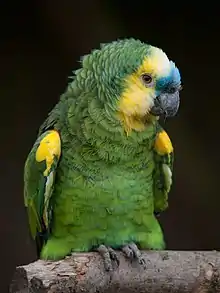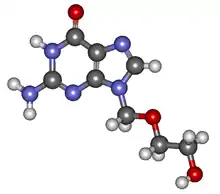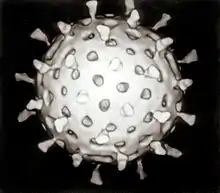Pacheco's disease
Pacheco's disease is a highly infectious and acute bird disease caused by a species of herpesvirus, Psittacid alphaherpesvirus 1 (PsHV-1).[1][2] All psittacine species are susceptible to Pacheco's disease, mainly those in zoological collections and aviaries in any geographic regions.[1] Specifically, Pacheco's disease has a high occurrence rate in Amazon parrots, followed by African grey parrots, parrots, macaws, cockatoos and conures.[4] Due to a very high mortality rate within these susceptible species, concerns are brought to companion bird markets and breeders.[5][6]
| Pacheco's disease | |
|---|---|
| Virus classification | |
| (unranked): | Virus |
| Realm: | Duplodnaviria |
| Kingdom: | Heunggongvirae |
| Phylum: | Peploviricota |
| Class: | Herviviricetes |
| Order: | Herpesvirales |
| Family: | Herpesviridae |
| Genus: | Iltovirus |
| Species: | |
| Synonyms | |
|
Herpes hepatosplenitis[3] | |
The main sign of Pacheco's disease is a sudden and rapid death of birds. It is often preceded by short, severe illnesses, which includes diarrhoea, lethargy, anorexia and inactivity.[7][8] The virus is transmitted between birds through ingestion, by contaminated food or water, as well as through inhalation and conjunctival exposure.[8] The rate that the virus can spread is highly influenced by its environment and living conditions.[9] Birds can then develop signs and symptoms weeks after being in contact with the virus.[10] If a bird survives Pacheco's disease, it may later develop internal papilloma disease in its gastrointestinal tract.[10]
Pacheco's disease is diagnosed through a DNA probe or chemical and serological testings.[3][11] No vaccine directly cures Pacheco's disease. There are only treatments with acyclovir and formalin-inactivated vaccine that helps prevent the virus from replicating.[12][13]
The first case of Pacheco's disease occurred in Brazil in 1930.[7] Since then, there have been multiple outbreaks globally including in Europe, Japan, Middle East and the U.S.[14] The main source of these outbreaks is mainly due to the importation of birds.[9]
Signs and symptoms

Birds infected with Pacheco's disease usually experience minor signs and symptoms that appear right before or after its death. Birds can have a watery, yellowish to greenish discolouration of urates and faeces or have moist droppings.[15][5] They can experience mucoid discharges from its nostrils, such as in blue-and-gold macaws and Amazon parrots, or a regurgitation of clear sanguineous fluids.[16][5] As the disease progresses, birds can become difficult to arouse, experience lethargy and somnolence as well as lose interest in eating and its normal daily activities.[17] Birds can also display signs of extreme depression only hours before its death.[7] However, due to the short and lack of severe clinical signs indicating a presence of the herpesvirus, the birds that experience a rapid death are found in excellent bodily conditions with full crops.[5] This means that birds often do not live long enough for the collection of its blood for testings or diagnoses.[14]
Laboratory tests can also display the abnormalities of tissues, such as a liver with pale yellow to brown patches in necrotic areas.[16] Examinations mainly present lesions in the bird's liver and spleen, such as an enlargement of both organs with diffuse patches of necrosis and the bleeding of broken capillaries (petechial haemorrhage).[14][1] There can also be minimal to no inflammatory response surrounding the necrotic areas.[17] By comparing these signs and symptoms to a healthy liver that displays no signs of reactions, this indicates a presence of the herpesvirus infection.
External factors surrounding the birds can also promote the spread of these signs and symptoms and infections.[15] Specifically, environmental changes, such as importing birds from a warm to cold environment as well as creating a stressful event for birds in crowded situations, often triggers a virus amplification and increased virulence.[18]
Cause
A virus, Psittacid alphaherpesvirus 1, is the etiologic agent that causes Pacheco's disease. This virus species is closely related to Gallid alphaherpesvirus 1.[2] It was initially identified as a herpesvirus by examining its virion size, sensitivity to ether, the formation of intranuclear inclusions, its ability to thicken the nuclear membranes of the host cells.[17]
Pacheco's disease is caused by at least three different serotypes of the herpesvirus.[19] The most common strain that causes Pacheco's disease is Serotype 1. This is followed by Serotype 2 and less frequently, Serotype 3.[4] In curing Pacheco's disease, the vaccine developed must protect the birds against these main three serotypes.[19]
Transmission
Although there is no exact route of transmission, Pacheco's disease is not transmissible by humans. [14] It is also not transmissible to other common laboratory animals, including guinea pigs, mice as well as other certain bird species, such as pigeons and canaries.[20][18] Adult birds that are infected with the herpesvirus causing Pacheco's disease can transmit and infect their parent-fed offspring, who may not develop signs.[21]
Pacheco's disease is usually spread by aerolisation or contact.[17] The main sources of contraction is through the faeces, oral and pharyngeal secretions of carrier birds where the virus has shed, or through contaminated food or water.[3] Once a bird has been infected and recovers from Pacheco's disease, it is permanently immune and becomes a carrier of the disease, whether it displays symptoms or not.[5] It is still able to release the virulent virus and so, bring risks into aviaries by infecting other healthy birds. These latently infected birds then become a potential source for future outbreaks as well as a spread of mucosal papillomas.[14][22] This makes it essential for all recently imported psittacine birds to be tested for the presence of the herpesvirus before entering a resident of aviaries.[16] Droppings of resident birds are also screened periodically to determine the presence of the virus.[9] Infected birds are quarantined and isolated from the rest of the birds to prevent any further transmissions or deaths.
Diagnosis
Pacheco's disease can be diagnosed both antemortem and post-mortem. By diagnosing an infected bird antemortem, a DNA probe runs serologically and detects the virus within the bird's internal system, mainly to find asymptomatic carriers.[3][23] This theoretically tests for all known herpesvirus serotypes that infect the birds and involves taking samples from the bird's oral cavity or cloaca, where the virus can be consistently detected in most parrots.[22][3] However, readings can often present a misleading indication that there is no presence of Pacheco's disease as a result of samples being collected at the time the bird is not shedding the herpesvirus.[3] The detection of the virus through the DNA probe also helps identify a contaminated environment the bird has recently been exposed to.[24]
An indirect immunoperoxidase method is another chemically sensitive and specific testing that laboratories have used to arrive at a reliable result in making a histopathological diagnosis of Pacheco's disease.[11] This test does not require highly complex devices or sources. It detects the presence of the avian alpha-herpesvirus, which is the causative agent, through an antiserum obtained in SPF chickens as well as another serum obtained from rabbit anti-chicken IgG that is conjugated with horseradish peroxidase.[11] By applying this test on post-mortem tissues, dark dispersed spotting on the liver and small intestines in necrotic areas display an indication of a reaction to the viral antigen.[11] This is possible due to the high degree of contrast between the viral antigen and host cell that allows a detection of Pacheco's disease.[11] This approach has successfully confirmed diagnoses in psittacine birds that were previously diagnosed with Pacheco's disease based on its clinical features and macroscopic lesions, indicating its accuracy and reliability.[11]
Serologic testing is another diagnosis method that detects the virus within the birds through antibody tests and overseeing the bird's antibody tiers.[24] This test involves observing the titre levels in paired serum samples.[24] Increasing titres indicate a recent infection while decreasing titres indicate that the antibodies in the immune system is no longer being stimulated.[24] However, these antibody tests are not as helpful in diagnosing birds that are already sick or those birds that do not live long enough to compare titres.[23] A bird infected with Pacheco's disease's virus antibody titre is considered latently infected.
Treatment

There is no effective vaccine that completely cures Pacheco's disease in infected birds. It is difficult to establish an effective treatment for Pacheco's disease as birds can suddenly die without displaying any symptoms.[11] However, there have been successful uses of acyclovir, an antiviral medication, in reducing high death rates by rapidly inhibiting the virus replication within the birds.[14][12] Acyclovir is a synthetic acyclic purine nucleoside that has strong activity against certain members of the herpesvirus group.[12] It is given to birds in the form of oral administration for numerous days or in an IV form.[3] Acyclovir has decreased morbidity and mortality during multiple Pacheco's disease outbreaks.[3] However, it cannot prevent the establishment of the carrier and latent infections.[5] This means that acyclovir cannot be used to cure the virus infection and infected birds will remain infected and become a carrier throughout its lifetime. [14]
An autogenous, formalin-inactivated vaccine, with an adjuvant of aluminium, hydroxide gel, has similarly been used in an outbreak, in 1999, to successfully protect psittacine birds from Pacheco's disease.[13] This vaccine was used to stop the rapid spread of the virus and helped maintain morbidity and mortality rates in psittacine birds within the zoo.[13] By injecting this in the birds, it effectively contained the outbreak, where no herpesvirus was isolated from faecal samples of the many psittacine birds after the outbreak occurred.[13]
Epidemiology
The first case that recognised Pacheco's disease occurred in 1930 in Brazil, from birds that were imported from South America.[25] It was not until 1933, when the causative agent was identified.[7] Since then, the global spread of Pacheco's disease has increased as a result of domestically raised birds or the transportation of aviaries that contains symptomatic and asymptomatic infected birds.
Outbreaks
In February 1933, an outbreak occurred in Campania, Italy. A shipment of 93 psittacine birds was imported to Campania, Italy, from Guayana, South America.[26] It contained macaws, Amazon parrots, conures and parakeets, who were all transferred to quarantine premises and were housed in cages, based on its size and genera.[26] All birds arrived in good and healthy conditions and were previously vaccinated against PPD and Poxviridae with a commercial vaccine containing PsiHV1.[26] However, 3 of the Conure parakeets suddenly died without displaying any relevant symptoms, followed by the rest of its species.[26] While certain species experienced high mortality rates, others had not, such as the A. Manilata, B. Cbyoptems and A. Mehnocepbala.[26] In this instance, the vaccine failed to serve its purpose as the vaccine only protected the birds against 1 serotype, rather than all 3 known serotypes that cause Pacheco's disease.[26] This raised concerns about how vaccines relating to Pacheco's disease should be developed in an attempt to protect birds from Pacheco's disease.[26]
The U.S. has encountered numerous psittacine-disease related incidences linking to Pacheco's disease:
In December 1977 and January 1978, multiple outbreaks had occurred in a privately owned bird import quarantine station that was located in Miami, Florida. In the first incident, the Floridan aviary imported 3 macaws from California into an aviary of 18 healthy birds.[18] This consisted of 7 macaws, 8 cockatoos, 2 hornbills and 1 mynah bird.[18][20] Within a week, the newly imported macaws had died, followed by the other macaws and cockatoos that were originally residing in the Floridan aviary.[18] The other non-psittacine birds, the mynah and hornbills, that were largely exposed to the virus spreading around in the aviary were not affected in this situation and survived the outbreak.[20] In the second incident, 2 macaws and 1 cockatoo that were imported had died.[18] Such high mortality rate in this same Floridan aviary was largely influenced by the overcrowding and stressful environment of the birds.[18] This provided an ideal setting for Pacheco's disease to spread and promote the infection by transmitting it from bird to bird.[18] In this instance, examinations of the birds that were presented for necropsy showed that each died suddenly without clear evidence of any sicknesses other than lethargy.[27] There are no linkages between both outbreaks.[27]
In March 1991, an outbreak had occurred in an aviary in Wyoming, despite being closed to newly introduced birds for 4 years.[28] Several bird species had died in this outbreak, including 2 golden mantle rosellas, 2 red-fronted parakeets, a yellow-bellied parrot and a double-yellow headed Amazon parrot.[28] These 6 birds showed few to no premonitory signs over the 2 weeks it resided in the aviary before its death.[28] Medical examinations showed an absence of gross lesions while the clinical signs confirmed Pacheco's disease as cause of death. This included watery, green diarrhoea as well as depression that terminated in death within a day.[28] In this instance, it is suspected that the source may have come from carrier species that were already residing in the aviary, such as the conures that are considered to be the main carriers of Pacheco's disease.[28]
References
- Ramis, Antonio; Tarrés, Jordi; Fondevila, Dolors; Ferrer, Luis (September 1996). "Immunocytochemical study of the pathogenesis of Pacheco's parrot disease in budgerigars". Veterinary Microbiology. 52 (1–2): 49–61. doi:10.1016/0378-1135(96)00062-4. ISSN 0378-1135. PMID 8914250.
- Tomaszewski, E.; Wilson, V. G.; Wigle, W. L.; Phalen, D. N. (2001-02-01). "Detection and Heterogeneity of Herpesviruses Causing Pacheco's Disease in Parrots". Journal of Clinical Microbiology. 39 (2): 533–538. doi:10.1128/jcm.39.2.533-538.2001. ISSN 0095-1137. PMC 87771. PMID 11158102.
- Harris, Don J.; Oglesbee, Barbara L. (2006), "Avian Infectious Diseases", Saunders Manual of Small Animal Practice, Elsevier, pp. 1740–1757, doi:10.1016/b0-72-160422-6/50171-6, ISBN 978-0-7216-0422-0
- Tomaszewski, Elizabeth K.; Kaleta, Erhard F.; Phalen, David N. (2003-10-15). "Molecular Phylogeny of the Psittacid Herpesviruses Causing Pacheco's Disease: Correlation of Genotype with Phenotypic Expression". Journal of Virology. 77 (20): 11260–11267. doi:10.1128/jvi.77.20.11260-11267.2003. ISSN 0022-538X. PMC 224986. PMID 14512573.
- "Hygiene Protocols for the Prevention and Control of Diseases (Particularly Beak and Feather Disease) in Australian Birds" (PDF). Department of Environment and Heritage. 2006. Retrieved 25 May 2020.
- Thureen, Dean R.; Keeler, Calvin L. (2006-08-15). "Psittacid Herpesvirus 1 and Infectious Laryngotracheitis Virus: Comparative Genome Sequence Analysis of Two Avian Alphaherpesviruses". Journal of Virology. 80 (16): 7863–7872. doi:10.1128/jvi.00134-06. ISSN 0022-538X. PMC 1563825. PMID 16873243.
- Galisky, E.; O'Brien, S. (1987-01-01). "Pacheco's Disease". Iowa State University Veterinarian. 49 (2). ISSN 0099-5851.
- Schmidt, Robert E.; Reavill, Drury R.; Phalen, David N., eds. (2003-01-01). Pathology of Pet and Aviary Birds. doi:10.1002/9780470376836. ISBN 9780470376836.
- Abdala, Nádia (1994-01-12). "Development of an Experimental ELISA for the Detection of Antigens and Antibodies to the Virus of Pacheco Disease using Monoclonal Antibodies". Journal of Veterinary Medicine, Series B. 41 (1–10): 369–380. doi:10.1111/j.1439-0450.1994.tb00240.x. ISSN 0931-1793.
- Doneley, Bob (2016). "Chapter 17: Disorders of the Liver". Avian Medicine and Surgery in Practice: Companion and Aviary Birds (2nd ed.). CRC Press. pp. 251–264. ISBN 9781482260199.
- Ramis, A.; Fondevila, Dolors; Tarres, J.; Ferrer, L. (September 1992). "Immunocytochemical diagnosis of Pacheco's disease". Avian Pathology. 21 (3): 523–527. doi:10.1080/03079459208418872. ISSN 0307-9457. PMID 18670969.
- Smith, C. Gregory (1987). "Use of Acyclovir in an Outbreak of Pacheco's Parrot Disease". AAV Today. 1 (2): 55–56. doi:10.2307/30134362. JSTOR 30134362.
- M, Barão Da Cunha; Jj, Correia; T, Fagulha; M, Fevereiro; Mc, Peleteiro; G, Vollrath; Ef, Kaleta (November 2007). "Pacheco's Parrot Disease in Macaws of the Lisbon's Zoological Garden. Description of an Outbreak, Diagnosis and Management, Including Vaccination". DTW. Deutsche Tierarztliche Wochenschrift. 114 (11): 423–8. PMID 18077933.
- "Psittacid Herpesviruses and Mucosal Papillomas of birds in Australia" (PDF). Wildlife Health Australia. 2017. Retrieved 24 May 2020.
- Gravendyck, M.; Balks, Elisabeth; Schröder‐Gravendyck, Astrid‐Sabine; Eskens, U.; Frank, H.; Marschang, Rachel E.; Kaleta, E. F. (October 1998). "Quantification of the herpesvirus content in various tissues and organs, and associated post mortem lesions of psittacine birds which died during an epornithic of pacheco's parrot disease (PPD)". Avian Pathology. 27 (5): 478–489. doi:10.1080/03079459808419372. ISSN 0307-9457. PMID 18484032.
- Panigrahy, B.; Grumbles, L. C. (July 1984). "Pacheco's Disease in Psittacine Birds". Avian Diseases. 28 (3): 808–12. doi:10.2307/1590254. ISSN 0005-2086. JSTOR 1590254. PMID 6091610.
- Godwin, J. S.; Jacobson, E. R.; Gaskin, J. M. (1982). "Effects of Pacheco's Parrot Disease Virus on Hematologic and Blood Chemistry Values of Quaker Parrots (Myopsitta monachus)". The Journal of Zoo Animal Medicine. 13 (3): 127. doi:10.2307/20094596. ISSN 0093-4526. JSTOR 20094596.
- Gaskin, J.M.; Robbins, C.M.; Jacobson, Elliott (1978-01-01). "An explosive outbreak of Pacheco's parrot disease and preliminary experimental findings". Proceeding in American Association of Zoo Veterinarians, Knoxville, Tennessee, Pp: 241–253.
- Kaleta, E. F. (1990-04-01). "Herpesviruses of birds ‐ a review". Avian Pathology. 19 (2): 193–211. doi:10.1080/03079459008418673. ISSN 0307-9457. PMID 18679931.
- Simpson, C. F.; Hanley, J. E.; Gaskin, J. M. (1975-04-01). "Psittacine Herpesvirus Infection Resembling Pacheco's Parrot Disease". Journal of Infectious Diseases. 131 (4): 390–396. doi:10.1093/infdis/131.4.390. ISSN 0022-1899. PMID 163868.
- Schmidt, Robert E., Reavill, Drury R. & Phalen, David N (2015). Pathology of Pet and Aviary Birds - 2nd Edition. Singapore: John Wiley & Sons, Inc. ISBN 978-1-118-82809-0.CS1 maint: multiple names: authors list (link)
- Tomaszewski, Elizabeth K.; Wigle, William; Phalen, David N. (November 2006). "Tissue Distribution of Psittacid Herpesviruses in Latently Infected Parrots, Repeated Sampling of Latently Infected Parrots and Prevalence of Latency in Parrots Submitted for Necropsy". Journal of Veterinary Diagnostic Investigation. 18 (6): 536–544. doi:10.1177/104063870601800603. ISSN 1040-6387. PMID 17121080.
- "VetFolio". www.vetfolio.com. Retrieved 2020-05-25.
- "Test Results". University of Georgia College of Veterinary Medicine. Retrieved 2020-05-25.
- Mayer, Joerg; DACLAM, Thomas M. Donnelly, BVSc (2012-12-06). Clinical Veterinary Advisor: Birds and Exotic Pets. Elsevier Health Sciences. ISBN 978-1-4160-3969-3.
- Magnino, S.; Conzo, G.; Fioretti, A.; Menna, L. F.; Rampin, T.; Sironi, G.; Fabbi, M.; Kaleta, E. F. (1996-01-12). "An Outbreak of Pacheco's Parrot Disease in Psittacine Birds Recently Imported to Campania, Italy: Isolation of Psittacid Herpesvirus 2". Journal of Veterinary Medicine, Series B. 43 (1–10): 631–637. doi:10.1111/j.1439-0450.1996.tb00362.x. ISSN 0931-1793. PMID 9011159.
- Simpson, Charles F.; Hanley, J. E. (1977). "Pacheco's Parrot Disease of Psittacine Birds". Avian Diseases. 21 (2): 209–219. doi:10.2307/1589341. ISSN 0005-2086. JSTOR 1589341. PMID 194568.
- O'Toole, Donal; Haven, Tom; Driscoll, Mike; Nunamaker, Carol (April 1992). "An Outbreak of Pacheco's Disease in an Aviary of Psittacines". Journal of Veterinary Diagnostic Investigation. 4 (2): 203–205. doi:10.1177/104063879200400220. ISSN 1040-6387. PMID 1319750.
